Slow Moving Vehicle (SMV) Emblem Makes Significant Contributions To Agricultural And Highway Safety Worldwide. 1961- 63 Developed By Kenneth A. Harkness, Department Of Agricultural Engineering On The Ohio State University Campus. 1964 Became An ASAE Standard 1968 Specified In National Uniform Vehicle Code 1971 First Asabe Standard Ratified By American National Standards Institute (ANSI). Became Occupation Safety And Health Act (OSHA) Regulation. Ohio Farm And Home Safety Committee Provided Leadership
In Achieving Acceptance Dedicated 1992
ASABE


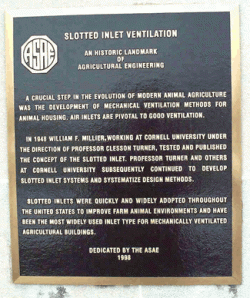
A Crucial Step In The Evolution Of Modern Animal Agriculture Was The Development Of Mechanical Ventilation Methods For Animal Housing. Air Inlets Are Pivotal To Good Ventilation. In 1948 William F. Millier, Working At Cornell University Under The Direction Of Professor Clesson Turner, Tested And Published The Concept Of The Slotted Inlet. Professor Turner And Others At Cornell University Subsequently Continued To Develop Slotted Inlet Systems And Systematize Design Methods.
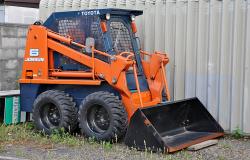
Brothers Cyril and Louis Keller designed and built the first small, lightweight, three-wheel, front-end loader in their machinist-blacksmith shop in Rothsay, Minnesota. A local farmer wanted to mechanize cleaning manure from his obstacle-filled, two-story turkey barn. The machine, first used in 1957, was able to turn completely around within its own length. Melroe Manufacturing Company, Gwinner, ND purchased the rights to the Keller loader and hired the Kellers to continue development of the loader in 1958.
In 1850, E. W. Quincy of Illinois patented an open-roll ear-snapping mechanism. A series of innovations led to corn heads for combines. Harvesting corn with corn pickers using open rolls on corn pickers after 1925 proved to be dangerous as farmers often needed to clear stalks from the rolls. In 1885, E. M. Aiken, Dawson, ND, patented shielded snapping rolls with flat plates above the rolls. C. K Shedd and E. V. Collins, Ames, IA, patented a more aggressive shielded snapping device in 1941 which was later used on sweet corn pickers.

In 1941, near Palouse, Washington, Raymond A. Hanson conceived of a self-leveling mechanism for hillside combines. On the steep hills in the Pacific Northwest, leveling is necessary to save grain because of the gravity grain separation mechanism. Before the Hanson invention, manual leveling required a person to stand on the combine platform and adjust the machine to the lay of the land - a hot, tedious job. The grain-saving attributes of Hanson's invention were probably more important than the labor saving, although both were valuable.

Scoates Hall 1932 A Historic Landmark of Agricultural Engineering Named for Daniels Scoates Designer of this Building Professor and Head Department of Agricultural Engineering 1919 to 1939 Eleventh President of ASAE Teacher, Writer, Engineer Counselor to Youth, His Example Still Inspires. Dedicated by the American Society of Agricultural Engineers 1978

The Rumely Companies, which operated in La Porte, Indiana, from 1853 to 1931, produced a variety of equipment including threshers and steam engines, which helped to change the nature of American and world agriculture. The revolutionary OilPull Tractor, which was introduced in 1910, used a unique carburetion system developed by John Secor, the Company's Chief Engineer. The OilPull tractor efficiently converted a low cost petroleum product to mechanical power, greatly reducing the need for animal and steam power on American farms. Dr.
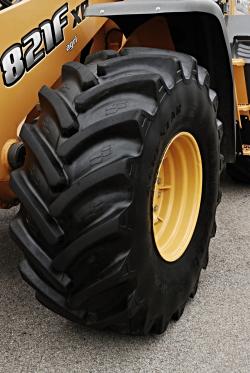
Early tractors were massive and expensive. Their steel lug wheels gave poor traction and a rough ride. Lugs were prohibited on many roads. 1926 Hoyle Pounds modified a Fordson tractor with zero pressure truck tires on special rims to improve performance on sandy soils in Winter Garden, FL.
A successful business resulted. In 1929 Hessel Roorda equipped Farmall tractors with low pressure rubber tires to pick corn in muddy fields near Rock Valley, IA. Farmers found they performed well in all conditions.

The First Agricultural Tractor Roll-Over Protection Structure (Rops) In The USA Resulted From Research By Lloyd H. Lamouria, Ralph R. Parks And Coby Lorensen At The Agricultural Engineering Department Of The University Of California At Davis. It Was Designed And Successfully Tested In The Summer Of 1956. It Was Exhibited And Reported At The Annual Meeting Of The Pacific Coast Section Of The American Society Of Agricultural Engineers (ASAE) In December 1956. Warren I. Hanson, Safety Coordinator, N.
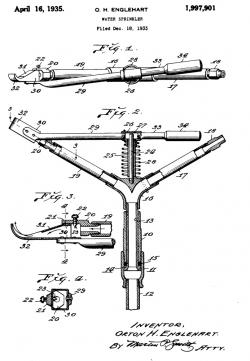
The Rain Bird horizontal action impact drive sprinkler head was invented in 1933 by Orton Englehardt, a citrus grower and native of Glendora. The design offered slow rotation and uniform watering, benefits long sought by local irrigators. Clement M. LaFetra, a friend of Englehardt, urged early patent application. A patent was awarded on December 18, 1933. Englehardt, with no entrepreneurial aspirations, assigned all rights to LaFetra and his wife Mary Elizabeth. Production began in the LaFetra family barn on October 13, 1935.
Innovations
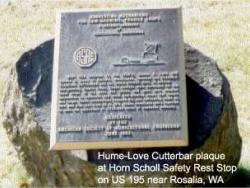
Near This Location In The 1930's James E. Love And Horace D. Hume Of Garfield, Washington, Invented The Flexible Floating Cutterbar And The Tined Pickup Reel To Harvest Low-Growing, Fragile Crops. These Devices Were Developed For The Local Crops Of Dry Peas And Lentils And Were Then…
Read More
In 1892, John H. Froehlich, Froehlich, IA, Mounted A Gasoline Fueled Internal Combustion Engine On A Traction Geared Frame And Used It To Power A Threshing Machine. A Change In Power Source Had Begun On North American Farms. In 1892, The Case Co., Racine, Wi, Built An Experimental Gas…
Read MoreIn 1926, Ives Hall, the original Agricultural Engineering Building at The Ohio State University, Columbus, was designated as ASAE's first engineering landmark in honor of department founder and 18th president of ASAE Fredrick Walter Ives. Frederick W. Ives 1884 - 1924.
Ives Hall was on…
Read More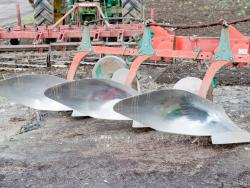
On this site in 1837 John Deere built the first successful self-scouring steel plow, thereby making a significant contribution to the development of American agriculture. Dedicated by American Society of Agricultural Engineers 1976
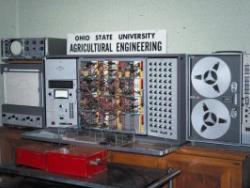
The first laser grade control was developed by agricultural engineers James Fouss and Norman Fausey of USDA's Agricultural Research Service at The Ohio State University in the mid-1960's. That system controlled the precise depth and grade of subsurface drains by regulating trenching and…
Read More
Luebben Hay Baler - Historic Landmark of Agricultural Engineering. In 1892, Hugh Luebben from Sutton, Nebraska, with sons Melchior and Ummo built a mobile machine to produce round hay bales between two sets of rotating flat belts. They began manufacturing the baler in 1909 in Beatrice…
Read More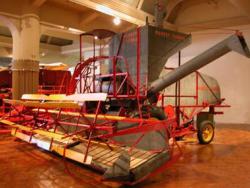
Designated A Historic Landmark Of Agricultural Engineering The Massey-Harris No. 20 was the First Commercially- Successful Self-Propelled Combine Used to Harvest Small Grains Under a Wide Variety of Conditions, World-Wide. Engineered By Thomas Carroll, Chief Engineer, Aided by Robert…
Read More
A Historic Landmark of Agricultural Engineering in 1834 Near the Village of Climax, Michigan, Hiram Moore and John Hascall Built and Put Into Practical Use the First Successful Grain Combined Harvester - Thresher Which was Patented June 28, 1836. This Achievement was a Significant…
Read More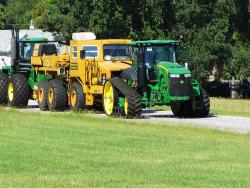
The First Official Nebraska Tractor Test was Started in this Building March 31, 1920. These Pioneer Tests Became Worldwide Standards and are Recognized by The American Society of Agricultural Engineers as an Historic Landmark of Agricultural Engineering. 1980

This machine is the world's first successful automatic pickup, self-tying hay baler. Its invention was a significant contribution to the development of American Agriculture. The baler was invented and hand-built in 1937 at Farmersville, Pa., a few miles from here. After testing and…
Read More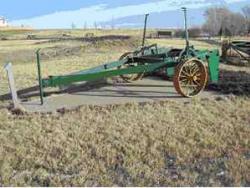
In the 1930's thousands of acres of land were rendered unproductive through wind erosion because of drought, tillage, and dust mulch farming practices. Charles S. Noble, of Nobleford, Alberta, invented a cultivator that sheared stubble and weeds below the ground surface, leaving residue on…
Read More
The concept of once-over mechanical, as opposed to multiple-pick hand or experimental multiple-pick machine harvesting, represented a major break-through in the practice of producing vine fruit such as pickling cucumbers. In the 1950s the cost of hand harvesting was as high as 50% of the…
Read More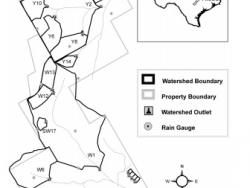
In the mid 1930's, the USDA Soil Conservation Service (SCS) realized the importance of hydrologic processes on agricultural fields and watersheds and determining their impact on soil erosion, floods, water resources, and the agricultural economy. In response, the SCS Hydrologic Division…
Read More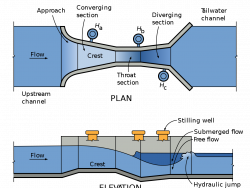
Since the beginning of irrigated agriculture, it has been important to measure flows of irrigation water. Accuracy of early water measurement methods often suffered because of trash or sediment in the water, or unusual flow conditions. Ralph L. Parshall saw this problem when he began…
Read More
William J. Conroy Of Aylmer, Quebec, Received Patent No. 465,127 On The First Field Hay Chopper On 15 December, 1891. Its Sickle Cut The Crop, Which Was Elevated Directly Into A Cylindrical Curved-Bar Cutterhead. It Was Not Commercially Successful, But It Recognized The Need.
… Read More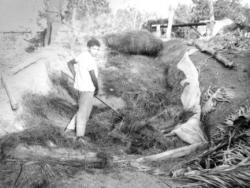
Designated a Historic Landmark of Agricultural Engineering at Oakland Manor In 1876 Francis Morris Built Brick Silos in His Barn and Introduced the Practice of Making Corn Silage in the United States. His Further Experiments Developed the Use of Earthen Trenches and Thereby Significantly…
Read More
Pole Frame Building Historic Landmark Of Agricultural Engineering - In the mid 1940's, "B G" Perkins of Doane Agricultural Service introduced a new pole-frame construction along the Missouri-Illinois border. This idea revolutionized the way barns were built. With pole-frame construction,…
Read More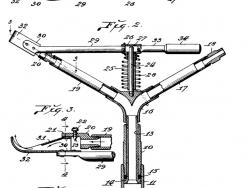
The Rain Bird horizontal action impact drive sprinkler head was invented in 1933 by Orton Englehardt, a citrus grower and native of Glendora. The design offered slow rotation and uniform watering, benefits long sought by local irrigators. Clement M. LaFetra, a friend of Englehardt, urged…
Read More
The First Agricultural Tractor Roll-Over Protection Structure (Rops) In The USA Resulted From Research By Lloyd H. Lamouria, Ralph R. Parks And Coby Lorensen At The Agricultural Engineering Department Of The University Of California At Davis. It Was Designed And Successfully Tested In The…
Read More


